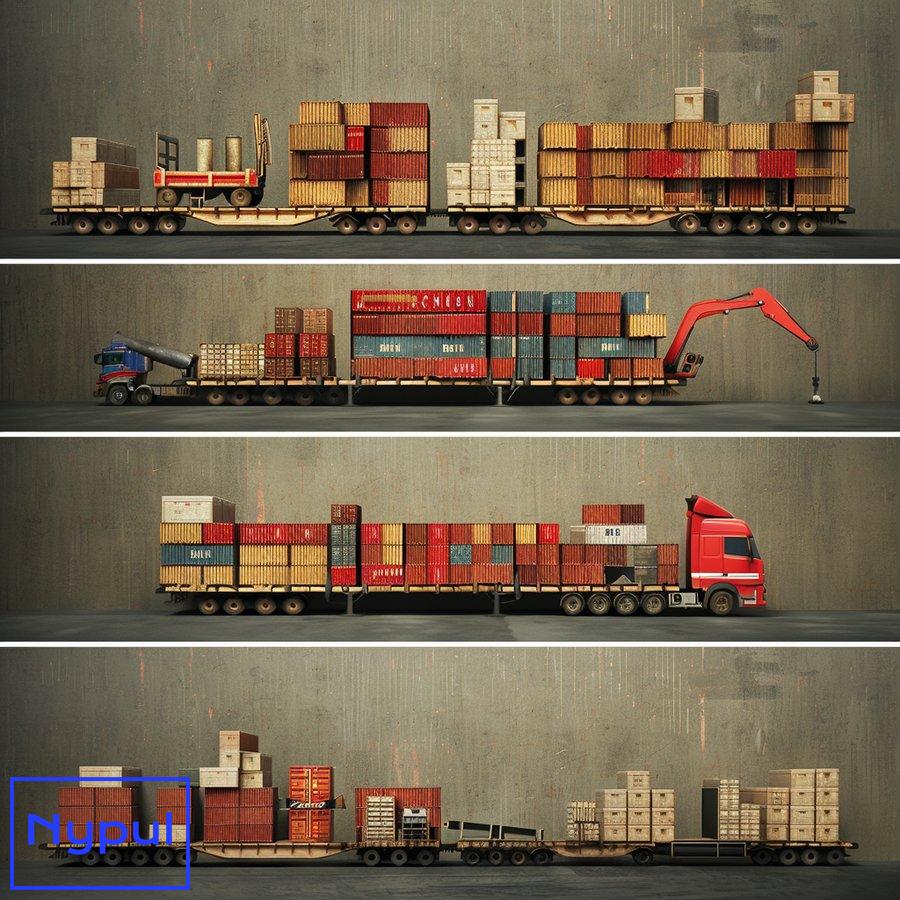What Precautions Must Be Taken if Driving With Cargo
Why is cargo safety crucial for drivers?
Cargo safety is paramount for drivers for several reasons. First and foremost, it ensures the protection of the goods being transported, which is crucial for maintaining customer trust and preserving the integrity of the supply chain. When cargo is properly secured and handled with care, it reduces the risk of damage, loss, or theft, ultimately leading to fewer claims and a more efficient delivery process.
Secondly, cargo safety is essential for the safety of the driver and other road users. Unsecured or improperly loaded cargo can shift during transit, causing the vehicle to become unstable and increasing the risk of accidents. In the event of a collision or sudden maneuver, loose cargo can become projectiles, potentially causing injury or even fatalities. By following proper cargo securement techniques and adjusting driving behaviors accordingly, drivers can minimize these risks and contribute to a safer driving environment for everyone on the road.

Moreover, cargo safety is a legal requirement in most jurisdictions. Drivers who fail to comply with cargo securement regulations can face hefty fines, license suspensions, or even criminal charges in the event of an incident. Maintaining proper cargo safety practices not only protects the driver and others but also helps avoid costly legal consequences and preserves the driver’s professional reputation.
In summary, cargo safety is a critical aspect of the driving profession that requires diligence, knowledge, and a commitment to best practices. By prioritizing cargo safety, drivers can protect their cargo, ensure their own safety and that of others, and maintain compliance with relevant laws and regulations.
How should drivers prepare for transporting cargo?
Before embarking on a cargo transport journey, drivers must thoroughly prepare to ensure a safe and successful trip. One of the most crucial steps is to conduct a thorough pre-trip inspection of the vehicle and its cargo securement equipment. This includes checking the condition of the tires, brakes, lights, and other critical components to ensure they are in proper working order. Drivers should also inspect the cargo securement devices, such as straps, chains, and tensioners, for any signs of wear or damage and replace them if necessary.
Another essential aspect of preparation is to familiarize oneself with the cargo being transported. Drivers should review the shipping documents to understand the nature, weight, and dimensions of the cargo, as well as any special handling requirements or hazards associated with it. This information is crucial for determining the appropriate cargo securement techniques and ensuring that the cargo is loaded and secured in a manner that minimizes the risk of shifting or damage during transit.
Drivers should also plan their route carefully, taking into account factors such as road conditions, weather forecasts, and potential traffic congestion. By anticipating potential challenges and obstacles, drivers can make informed decisions about their driving behaviors and adjust their cargo securement techniques accordingly.
Finally, drivers should ensure that they are well-rested, hydrated, and mentally alert before embarking on their journey. Fatigue and distractions can significantly impair a driver’s ability to operate their vehicle safely and respond effectively to unexpected situations. By prioritizing their own well-being and fitness for duty, drivers can minimize the risk of accidents and ensure that they are fully prepared to handle any challenges that may arise during the transport of cargo.
What are the proper cargo securement techniques?
Proper cargo securement is essential for ensuring the safety of the driver, the vehicle, and other road users. There are several techniques that drivers can employ to secure their cargo effectively:
Direct Tiedown: This method involves using a combination of tiedown assemblies (e.g., straps, chains, or cables) to secure the cargo directly to the vehicle’s securement points. The tiedown assemblies should be arranged in a criss-cross pattern to prevent the cargo from shifting in any direction. The tension in the tiedowns should be checked regularly during the trip to ensure that the cargo remains secure.

Indirect Tiedown: In this method, the cargo is secured to itself or to other cargo using tiedown assemblies. This technique is often used for securing cargo that is stacked or nested together. The tiedowns should be arranged in a manner that prevents the cargo from shifting or toppling over during transit.
Blocking and Bracing: Blocking and bracing involve the use of dunnage (e.g., wooden blocks or bars) to prevent the cargo from shifting or sliding. The dunnage should be placed between the cargo and the vehicle’s walls or other cargo to create a tight fit and prevent movement. This technique is often used in conjunction with tiedowns to provide additional stability.
Friction Mats: Friction mats are placed between the cargo and the vehicle’s floor or walls to increase the coefficient of friction and reduce the likelihood of sliding. These mats are particularly useful for securing smooth-surfaced cargo, such as metal sheets or plastic containers.
Load Securement Devices: Drivers should use appropriate load securement devices, such as tiedown assemblies, edge protectors, and anti-skid mats, to ensure the cargo remains secure during transit. These devices should be inspected regularly for wear and tear and replaced if necessary.
When selecting cargo securement techniques, drivers should consider the weight, size, and shape of the cargo, as well as the vehicle’s load capacity and the road conditions. By employing proper cargo securement techniques and using appropriate load securement devices, drivers can minimize the risk of cargo shifting or loss during transit and ensure the safety of themselves and others on the road.
How can drivers optimize cargo loading for safety?
Optimizing cargo loading is crucial for ensuring the safety and stability of the vehicle during transit. Drivers should follow these best practices to ensure that the cargo is loaded in a manner that minimizes the risk of shifting or damage:
Weight Distribution: Proper weight distribution is essential for maintaining vehicle stability and control. Drivers should ensure that the cargo is evenly distributed across the vehicle’s axles, with heavier items placed closer to the front axle. This helps to maintain the vehicle’s center of gravity and reduces the risk of jackknifing or rollover.

Stacking and Tiering: When stacking or tiering cargo, drivers should ensure that the cargo is stable and secure. Heavier items should be placed at the bottom, with lighter items stacked on top. Cargo should be stacked in a manner that prevents it from shifting or toppling over during transit.
Separation and Stabilization: Cargo should be separated and stabilized to prevent shifting or damage during transit. Drivers should use dunnage, friction mats, or other load securement devices to create a tight fit and prevent movement. Cargo should also be separated by type or weight to prevent damage or contamination.
Accessibility: Drivers should ensure that the cargo is loaded in a manner that allows for easy access and unloading at the destination. This may involve placing frequently accessed items near the rear of the vehicle or using a side-loading configuration.
Hazardous Materials: When transporting hazardous materials, drivers should ensure that the cargo is properly labeled, packaged, and secured according to applicable regulations. Hazardous materials should be separated from other cargo and placed in a manner that minimizes the risk of leakage or contamination.
By optimizing cargo loading and following best practices for weight distribution, stacking, separation, and hazardous materials handling, drivers can ensure the safety and stability of their vehicle during transit and minimize the risk of cargo shifting or damage.
What in-transit monitoring procedures should drivers follow?
During the transport of cargo, drivers must remain vigilant and monitor the cargo and vehicle regularly to ensure the continued safety and integrity of the load. Here are some key in-transit monitoring procedures that drivers should follow:
Regular Inspections: Drivers should conduct regular inspections of the cargo and vehicle during stops, such as rest areas or weigh stations. These inspections should include checking the condition of the cargo securement devices, the cargo itself for any signs of shifting or damage, and the vehicle for any changes in handling or performance.
Observation During Driving: While driving, drivers should remain alert for any changes in the vehicle’s handling or performance that may indicate a problem with the cargo. This includes monitoring the vehicle’s stability, steering, and braking, as well as any unusual noises or vibrations that may indicate a shifting or damaged load.
Communication with Dispatch: Drivers should maintain regular communication with their dispatch or fleet management team to report any issues or concerns related to the cargo or vehicle. This includes reporting any damage, loss, or theft of cargo, as well as any changes in the vehicle’s condition or performance that may affect the safety or integrity of the load.
Documentation: Drivers should maintain accurate documentation of the cargo, including the shipping documents, bill of lading, and any other relevant paperwork. This documentation should be kept up-to-date and readily available in case of an incident or inspection.
Adherence to Regulations: Drivers should be familiar with and adhere to all applicable regulations related to cargo transport, including weight limits, cargo securement requirements, and hazardous materials handling. By following these regulations and best practices, drivers can minimize the risk of incidents and ensure the safe and compliant transport of cargo.
By following these in-transit monitoring procedures, drivers can proactively identify and address any issues related to the cargo or vehicle, ensuring the continued safety and integrity of the load throughout the transport process.
How should driving techniques be adjusted when carrying cargo?
When transporting cargo, drivers must adjust their driving techniques to account for the additional weight, size, and handling characteristics of the loaded vehicle. Here are some key adjustments that drivers should make:

Speed Adjustment: Drivers should reduce their speed when carrying cargo, especially when navigating curves, hills, or other challenging road conditions. Cargo can significantly affect a vehicle’s stability and handling, increasing the risk of rollovers or jackknifing at higher speeds.
Following Distance: Drivers should increase their following distance when carrying cargo, allowing for more time and space to react to changing road conditions or the actions of other drivers. Heavier vehicles require more distance to come to a complete stop, and cargo can shift during braking, affecting the vehicle’s stability and control.
Lane Positioning: Drivers should position their vehicle in the center of the lane, avoiding sudden lane changes or maneuvers that could cause the cargo to shift or the vehicle to become unstable. When passing or merging, drivers should ensure that they have sufficient space and time to complete the maneuver safely.
Braking Technique: Drivers should use a smooth, gradual braking technique when carrying cargo, avoiding sudden or hard braking that could cause the cargo to shift or the vehicle to become unstable. Drivers should also be aware of the increased stopping distance required for heavier vehicles and adjust their braking accordingly.
Turning Technique: When turning, drivers should use a wide turning radius to prevent the cargo from shifting or the vehicle from becoming unstable. Drivers should also be aware of the increased off-tracking (the difference between the path of the front and rear wheels) of longer vehicles and adjust their turns accordingly.
Backing Up: Backing up with cargo requires extra caution and skill. Drivers should use a spotter or guide when available and take their time to ensure that the vehicle is positioned correctly before beginning to back up. Drivers should also be aware of the increased blind spots and reduced visibility when carrying cargo and adjust their backing techniques accordingly.
By adjusting their driving techniques to account for the additional weight, size, and handling characteristics of the loaded vehicle, drivers can minimize the risk of incidents and ensure the safe transport of cargo.
What emergency procedures are essential for cargo transport?
In the event of an emergency or incident during cargo transport, drivers must be prepared to respond quickly and effectively to minimize the risk of injury, damage, or loss. Here are some essential emergency procedures that drivers should be familiar with and ready to implement:
Incident Reporting: Drivers should be trained in proper incident reporting procedures, including how to contact emergency services, their dispatch or fleet management team, and any other relevant parties. Drivers should also be familiar with the information that will be required in an incident report, such as the location, nature of the incident, and any injuries or damage sustained.
Cargo Securement: In the event of an incident, drivers should be prepared to re-secure or stabilize the cargo if necessary. This may involve using additional tiedowns, dunnage, or other load securement devices to prevent further shifting or damage. Drivers should also be aware of any special handling requirements for hazardous materials or perishable goods.
Vehicle Stabilization: Drivers should be trained in vehicle stabilization techniques, such as setting the parking brake, chocking the wheels, and using emergency triangles or flares to alert other drivers. Drivers should also be familiar with the location and use of emergency equipment, such as fire extinguishers and first aid kits.
Evacuation Procedures: In the event of a fire or other immediate threat, drivers should be prepared to evacuate the vehicle and move to a safe location. Drivers should be familiar with the location of emergency exits and escape routes, and should practice evacuation drills regularly.
Hazardous Materials Response: When transporting hazardous materials, drivers should be trained in proper response procedures in the event of a spill or release. This may include using personal protective equipment, containing the spill, and notifying emergency services and other relevant parties.
Post-Incident Procedures: After an incident, drivers should be prepared to cooperate with law enforcement, insurance adjusters, and other parties as needed. Drivers should also be familiar with their company’s policies and procedures for reporting incidents and completing necessary paperwork.
By being prepared for emergencies and having a clear understanding of essential emergency procedures, drivers can minimize the risk of injury, damage, or loss in the event of an incident during cargo transport.
Which technologies enhance cargo security during transport?
Several technologies are available to enhance cargo security during transport, helping to prevent theft, damage, and loss. Here are some of the most effective technologies:
GPS Tracking: GPS tracking systems allow fleet managers and dispatchers to monitor the location and movement of vehicles in real-time. This helps to detect unauthorized stops or deviations from the planned route, and can also provide valuable data for optimizing routes and improving efficiency.
Cargo Sensors: Cargo sensors can be used to monitor the condition and integrity of the cargo during transport. These sensors can detect changes in temperature, humidity, or vibration that may indicate a problem with the cargo, and can send alerts to the driver or dispatcher.
Tamper-Evident Seals: Tamper-evident seals are used to secure cargo containers and trailers, providing a visual indication if the seal has been broken. These seals can help to deter theft and provide evidence if a security breach has occurred.
Trailer Locks: Trailer locks are used to secure the rear doors of cargo trailers, preventing unauthorized access. These locks can be operated remotely or manually, and can be integrated with other security systems.
Cargo Cameras: Cargo cameras can be used to monitor the interior of cargo trailers, providing visual confirmation of the cargo’s condition and security. These cameras can be integrated with other security systems and can provide valuable evidence in the event of an incident.
Geofencing: Geofencing is a technology that uses GPS or RFID to define virtual boundaries around specific locations, such as warehouses or loading docks. When a vehicle enters or leaves a geofenced area, an alert can be sent to the dispatcher or fleet manager, helping to detect unauthorized stops or deviations from the planned route.
By using these technologies in combination with other security measures, such as driver training and secure loading and unloading procedures, cargo transport companies can enhance the security of their operations and reduce the risk of theft, damage, and loss.
What legal and insurance considerations apply to cargo drivers?
Cargo drivers must be aware of the legal and insurance considerations that apply to their profession, as these can have significant implications for their safety, liability, and financial well-being. Here are some key considerations:
Licensing and Training: Cargo drivers must hold the appropriate licenses and certifications for the type of vehicle and cargo they are transporting. This may include a commercial driver’s license (CDL) and specialized training for handling hazardous materials or oversized loads. Drivers should ensure that their licenses are up-to-date and that they have completed all required training.
Hours of Service Regulations: Cargo drivers are subject to hours of service regulations that limit the number of hours they can drive per day and week. These regulations are designed to prevent driver fatigue and improve safety on the roads. Drivers must keep accurate records of their driving time and comply with all applicable regulations.
Cargo Securement Regulations: Cargo drivers must comply with cargo securement regulations that specify how cargo must be loaded and secured to prevent shifting or loss during transit. These regulations vary by jurisdiction and cargo type, and drivers should be familiar with the specific requirements that apply to their operations.
Liability Insurance: Cargo drivers must have adequate liability insurance coverage to protect themselves and their employers in the event of an accident or incident. This may include coverage for bodily injury, property damage, and cargo loss or damage. Drivers should review their insurance policies regularly and ensure that they have sufficient coverage for their specific operations.
Cargo Insurance: In addition to liability insurance, cargo drivers may also need cargo insurance to protect the goods they are transporting. This coverage can help to reimburse the shipper or owner of the cargo in the event of loss, damage, or theft during transit. Drivers should be familiar with the cargo insurance requirements of their employers and shippers.
Hazardous Materials Regulations: When transporting hazardous materials, cargo drivers must comply with additional regulations that specify how these materials must be packaged, labeled, and handled. Drivers must have the appropriate training and certifications for handling hazardous materials and must follow all applicable safety protocols.
By being aware of these legal and insurance considerations and complying with all applicable regulations, cargo drivers can protect themselves, their employers, and the goods they are transporting, while minimizing the risk of costly legal and financial consequences.






